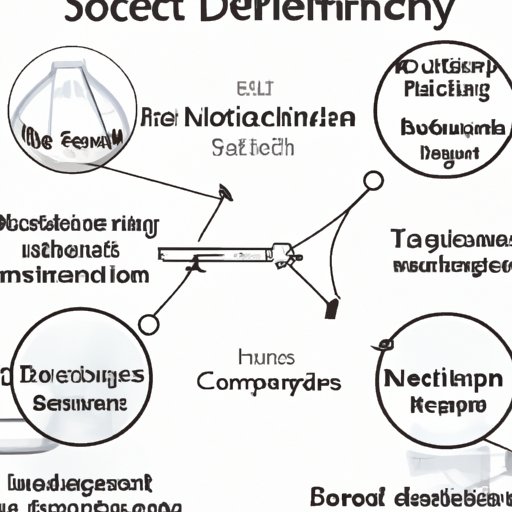Introduction
The scientific method is a structured approach to gathering and analyzing evidence to answer questions about the world around us. It is used by scientists, engineers, and researchers to investigate, understand, and explain natural phenomena. By following the scientific method, researchers can ensure that their work is rigorous and consistent.
At its core, the scientific method involves asking a question, researching existing knowledge on the topic, formulating a hypothesis, testing the hypothesis through experimentation, analyzing the results, and drawing conclusions. This process allows researchers to gain a deeper understanding of the physical world and develop new theories and technologies.
Explaining the Steps of the Scientific Method
The scientific method consists of six distinct steps: asking a question, doing background research, formulating a hypothesis, testing your hypothesis through experimentation, analyzing your data and drawing a conclusion.
Step 1: Ask a Question
The first step of the scientific method is to identify a question that can be answered through experimentation or observation. This question should be specific enough that it can be tested and answered as accurately as possible.
Step 2: Do Background Research
Once a question has been identified, the next step is to do some background research to find out what is already known about the topic. This allows researchers to build upon existing knowledge and develop a better understanding of the issue they are studying.
Step 3: Formulate a Hypothesis
After completing the necessary research, the researcher can then formulate a hypothesis. A hypothesis is an educated guess as to the answer to the original question. It should be based on the available evidence and should be testable.
Step 4: Test Your Hypothesis by Doing an Experiment
The fourth step of the scientific method is to conduct an experiment to test the hypothesis. During the experiment, variables should be carefully controlled so that only the variable being tested is affected. The experiment should be repeated multiple times to ensure accuracy.
Step 5: Analyze Your Data and Draw a Conclusion
Once the experiment has been completed, the researcher must analyze the data collected and draw a conclusion. This conclusion should be based on the evidence gathered during the experiment and should address the original question.
Examining the Benefits of Using the Scientific Method
One of the primary advantages of using the scientific method is its objectivity. By following a set of steps, researchers can ensure that their work is rigorous and unbiased. This helps to minimize errors and increase the accuracy of the results.
The scientific method also provides a systematic approach for exploring the natural world. By asking questions, conducting experiments, and analyzing data, researchers can gain a better understanding of the phenomena they are studying.
Finally, the scientific method can provide insight into natural phenomena that may have otherwise gone unnoticed. By making observations and testing hypotheses, researchers can uncover new information that can help further our understanding of the universe.

Outlining the Limitations of the Scientific Method
While the scientific method can be an effective tool for uncovering new knowledge, it is not without its limitations. One of the primary drawbacks of the scientific method is that it can be time consuming. Experiments must be carefully designed and conducted, which can take a considerable amount of time.
Another limitation of the scientific method is that it can be difficult to replicate results. Due to the complexity of natural phenomena, it may be impossible to accurately reproduce the same results in a different setting.
Finally, the scientific method may not be applicable to all areas of study. Some phenomena, such as human behavior, may be too complex to be studied effectively through the scientific method.

Investigating Historical Examples to Illustrate the Scientific Method
Throughout history, there have been numerous examples of scientists and researchers utilizing the scientific method to make groundbreaking discoveries. Galileo Galilei, for example, used the scientific method to challenge the prevailing view that the Earth was the center of the universe. Isaac Newton similarly used the scientific method to discover the laws of motion and gravity. Charles Darwin utilized the scientific method to develop his theory of evolution.
Comparing Different Types of Scientific Methodologies
There are two main types of scientific methodologies – qualitative and quantitative methods. Qualitative methods involve the collection of non-numerical data, such as interviews and surveys. Quantitative methods involve the collection of numerical data, such as experiments and measurements.
In addition, there are two main approaches to the scientific method – inductive and deductive methods. Inductive methods involve making generalizations from specific observations. Deductive methods involve making specific predictions from general theories.

Debating the Merits and Flaws of the Scientific Method
The scientific method has been used for centuries to investigate, understand, and explain natural phenomena. While it can be an effective tool for uncovering new knowledge, there are both advantages and disadvantages to using the scientific method.
Advantages
The scientific method is an objective and systematic approach to studying the world around us. It allows researchers to gain a deeper understanding of natural phenomena and develop new theories and technologies.
Disadvantages
The scientific method can be time consuming and difficult to replicate. In addition, it may not be applicable to all areas of study.
Conclusion
The scientific method is a structured approach to gathering and analyzing evidence to answer questions about the world around us. By following the scientific method, researchers can ensure that their work is rigorous and consistent. There are both benefits and drawbacks to using the scientific method, but it remains an invaluable tool for uncovering new knowledge about the natural world.
(Note: Is this article not meeting your expectations? Do you have knowledge or insights to share? Unlock new opportunities and expand your reach by joining our authors team. Click Registration to join us and share your expertise with our readers.)
